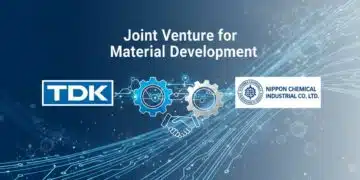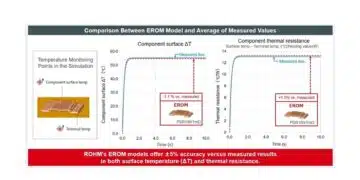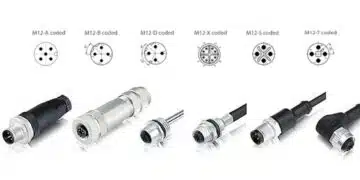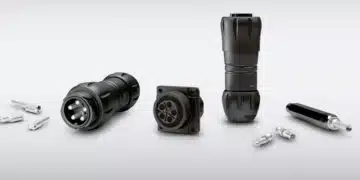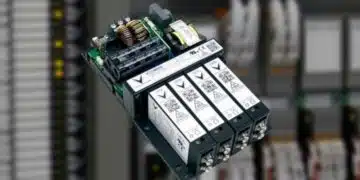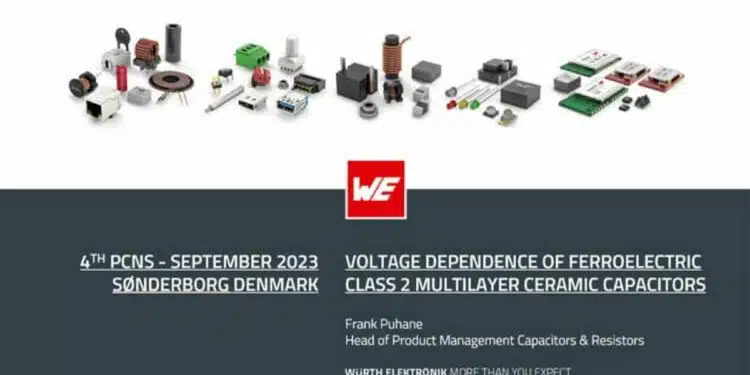This paper describes the physical background of the voltage-dependent capacitance of class II Multilayer Ceramic Capacitors (MLCC) and present models for this dependency.
The paper was presented by Frank Puhane, Würth Elektronik, Germany at the 4th PCNS 10-14th September 2023, Sønderborg, Denmark as paper No.2.3.
Introduction
This article focuses on the voltage dependence of class 2 Multilayer Ceramic Capacitors (MLCCs), particularly their ferroelectric properties and how these influence capacitance under DC voltage. Two main processes are examined: an immediate response due to dipole reorientation and a long-term aging effect, likely related to domain wall movement. Understanding these behaviors is crucial for accurate electronic circuit design and simulation.
Key Points
- Class 2 MLCCs display high capacitance and low loss due to their ferroelectric materials, like barium titanate.
- Immediate capacitance changes occur due to the fast reorientation of dipoles under DC bias.
- Long-term capacitance decreases are attributed to slow domain wall movement and aging effects.
- Mathematical models, like the Miller polarization model and time-dependent aging model, enable accurate simulation of voltage-dependent behaviors.
- Design-in requires accounting for both immediate and long-term capacitance reductions.
Extended Summary
Ferroelectric class 2 MLCCs, typically made with barium titanate, exhibit spontaneous polarization due to their non-centrosymmetric crystalline structure. Below the Curie temperature, their dipoles are organized into domains that collectively respond to applied electric fields. Above the Curie temperature, this alignment is lost, resulting in paraelectric behavior.
When a DC voltage is applied, an immediate polarization process occurs as domain dipoles align with the field. This reorientation restricts dipole motion, reducing the change in charge (dq) per voltage change (dV), and thus the capacitance, expressed as . Hysteresis arises due to remanent polarization and coercive fields (Ec), and capacitance peaks occur when the external field matches the coercive field during polarization reversal. A suitable model for this behavior is:
where parameters a, b, c, CS, and VC can be derived from measurements.
Over longer periods under DC bias, domain wall motion causes further capacitance reduction. This aging effect, often within 10–20% over hundreds to thousands of hours, depends on applied voltage and temperature. Two primary explanations are proposed: reorientation of 90° domains and a reduction in polarizable domain wall regions. The long-term behavior is modeled as:
with C0 as the initial capacitance, C∞ the saturation value, τ the characteristic time, and α a form factor.
Practical measurements demonstrate that initial capacitance drop is more significant than the long-term aging effect. At lower voltages, aging becomes relatively more prominent. Design engineers should consider both processes when selecting MLCCs, accounting for operational voltage, duration, and the expected decrease in usable capacitance.
Conclusion
Understanding the immediate and long-term voltage-dependent behaviors of class 2 MLCCs is essential for reliable circuit design. Immediate effects arise from dipole reorientation, while long-term changes are linked to domain wall motion and aging. Mathematical models based on measurable physical parameters enable accurate simulations and informed component selection. To ensure performance, designers should anticipate capacitance reduction and appropriately oversize MLCCs based on operating conditions and aging characteristics.




